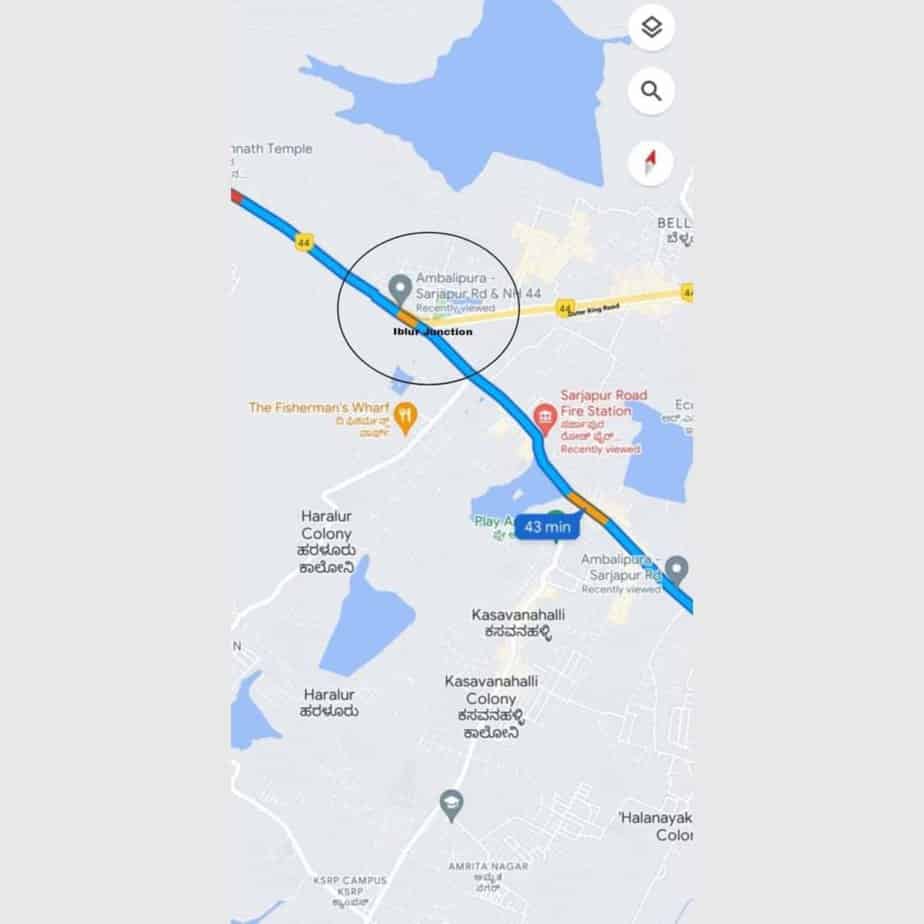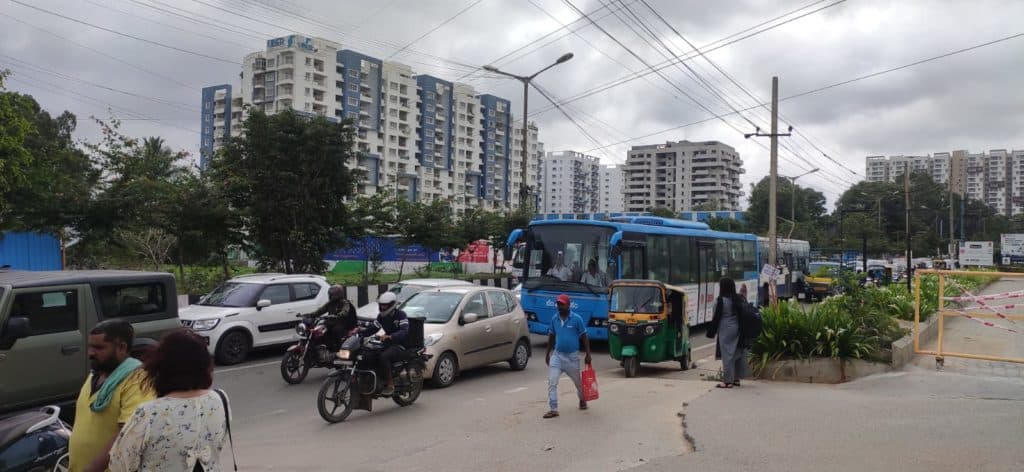I was born and brought up in Mumbai but am currently based in Bengaluru. So traffic jams do not deter me from reaching my destination. But Bengaluru’s traffic issues seem to be different in some respects. To understand better why it happens and what it is like to be stuck in Bengaluru’s traffic jam, I decided to travel through Iblur Junction at the peak-morning-office hours by two different modes of commute: a two-wheeler and a BMTC bus.
The Iblur Junction is the main connecting point between the Ambalipura-Sarjapur Road and the Outer Ring Road. Hence sees dense traffic and not only at peak times.
On June 14, I set out at 8:30 am on a two-wheeler from Sarjapura Police Station to reach Koramangala-100 feet road, a distance of about 22 km. Covering the full distance took me around two hours, given the many traffic bottlenecks I encountered on the way.
Given that I take all driving rules, regulations and etiquette seriously, I managed to reach the Sarjapur Fire Station, about 10-12 km away, by 8:50 am as this stretch of the road has light traffic most of the day. The next 1.5kms to Haralur Main Road Junction took 30 minutes. The next 500 m to Iblur junction took 25 minutes. From there to Agara Floyer-27th Main Road Junction took 15 minutes. My trip finally ended at Koramangala 100-ft Road, another 6 km away, by 10:30 am, a full two hours after I started my journey.
Read more: A sustainable plan to solve traffic woes at Iblur Junction
The first spot of massive traffic congestion I encountered was at the Sarjapur Road Fire Station. “The mornings are doubly jammed,” said C Yellappa, an auto driver who regularly drives through Sarjapur road. “This road is used by office-going commuters and school buses. Evenings too, when people come back home the road gets jammed.”
Bengaluru’s infamous traffic jams in some of the city’s major road junctions, of which the Iblur junction is one, have suddenly been hitting the headlines. About a month ago, a tweet made the rounds taking a dig at Bengaluru’s traffic saga offering to sell the 3rd, 4th and 5th gears of a car as they remain unused!

More recently, it was Chief Minister Basavaraj Bommai and the city’s top civic officials suddenly waking up to this problem that made the news.
CM proposes, BBMP disposes
Two weeks ago, CM Bommai, passed an order to decongest traffic bottlenecks at ten significant hotspots like Mahadevapura, Outer Ring Road, Silk Board Junction, Hebbal and Whitefield Road. These locations lie on some of the arterial, sub-arterial, and high-density roads in the city.
The CM met with the officials from the Bangalore water supply and sewerage board (BWSSB), Bruhat Bengaluru Mahanagara Palike (BBMP), the Urban Development, the Police, and other departments to find workable solutions for the traffic mess.
A few aspects discussed at the meeting were traffic signal synchronisation, fixing issues related to road digging, potholes and unattended debris. The meeting aimed at getting the BBMP, the BWSSB, the Bangalore Metro Rail Corporation Limited (BMRCL), and the Bangalore Electricity Supply Company Limited (BESCOM) to one table and collaborate under the direction of the Additional Chief Secretaries of the Home and Urban Development departments.

Traversing Sarjapur Road by bus
But coming back to part two of my experience, I took the 342F bus that leaves Sarjapur Bus Depot for Kempegowda Bus Station (Majestic Bus Stop) on June 23rd at around 8:20 am. The bus reached Iblur Junction at around 9:35 am, covering a distance of 15 km.
Again, the most congested part of the trip was the distance between the Sarjapur Road Fire Station to Manipal Hospital at Iblur Junction, a distance of less than a kilometre. Midway comes the problematic Haralur Road Junction, roughly equidistant from the fire station and Iblur Junction. I reached Koramangala Bus Stop, where I got off, at around 10:05 am. (Distance from Iblur Junction to Koramangala Stop is 3.5kms)
The trip took me 1:45 hours.
Read more: Traffic congestion, chaos reigns at the Sarjapur-Attibele junction
There have been proposals to resolve the bottlenecks on the Sarjapur Road. There is a plan to widen Sarjapur Road, which is stuck with land acquisition issues. The BBMP has proposed an underpass at the Haralur Road Junction at an estimated cost of Rs. 23 crores. The residents in the locality have opposed the project as they believe that the underpass would not help resolve the bottleneck.
Another issue at Iblur Junction, on the Outer Ring Road, is the traffic signal which is green for just 60 seconds and 90 seconds.
Metro construction making things worse
The bottleneck at Iblur junction has been made worse since the start of construction of the Metro line on the ORR connecting to the Silk Board to Hebbal line via the Iblur Junction. On my two-wheeler, it took me almost 30 minutes to move from Sarjapur Road Fire Station to the Haralur Road Junction at Sarjapur Road. And another 30 minutes from that point to reach the Agara Flyover-27th Main Road Junction, which is roughly a distance of 2kms.
In fact, on August 21, 2021, Additional Chief Secretary, Department of Electronics, IT, BT & Science and Technology, E V Ramana Reddy, issued an advisory to the National Association of Software and Service Companies (NASSCOM), asking over 800 companies housed in tech parks along the ORR, with a work-force of 1.5 lakh IT professionals to extend Work from Home (WFH) for their employees till December 2022. But it would seem the advisory has largely been ignored.
So, what is the way forward? What we see today are band-aid solutions. A classic example is constructing flyovers. “What we need is a comprehensive integrated sustainable public transport system, something like a central transport authority like you have in London or Singapore,” says traffic and mobility expert Prof M N Sreehari. “Our culture of working in silos and different transport systems, not talking to each other, is not going to work.”
The story the numbers tell
Since the beginning of t2022, the number of private vehicles on Bengaluru’s roads shot up from 50.33 lakh (2011 -12) to 1.04 crore (till March 2022 comprising 69.31 lakh two-wheelers and about 21.97 lakh cars. The number of buses has also gone up from 6064 to 6763 as of currently May 20.
In a BBC report, Pawan Mulukutla of the World Resource Centre wrote: “In 2005, traffic moved at a speed of 35km (22 miles) an hour; in 2014, it had slowed down to 9.2km (5.7 miles)”. That number is likely to be even lower today.
Mulukutla further adds, “…the wait time (in a traffic jam) is more than five minutes when it should ideally be two-three minutes.”
In the same report, Prof M N Sreehari (transport and traffic expert) opines that an average commuter in Bengaluru spends more than 240 hours in traffic jams and that this could possibly cost the city 65bn rupees ($950m; £760m) a year.
School children sit in buses for 2 hours to reach koramangala. Seeing the future of our country inside these buses breathing toxic fumes breaks my heart. Not to mention the number of school hours they miss due to the aftermath of pollution.It is not easy to move kids from one school to another, which is another issue. In some cities the police commissioner has asked schools to finish drop offs before the office traffic starts. It could save a lot of time at least 30-45 mins, For both office goers and school kids.
The traffic jams in cities in India, in metropolitan and major cities are a common phenomenon. It calls for long term strategieswith a visionary approach. . Bengaluru is the prime city of Karnataka since the colonial days. However, it has experienced accelerated growth and has overtaken Chennai in term of population and motor vehicles since 2011 and the consequence is the maddening traffic, congestion, pollution, accidents and ascending crime rates.
Sustainable Urban Development(SUD) rather than the sustainable transport development may be the key. SUD calls for decentralisation of the population and activities of the first cities. The root cause of the problem is the immigration from the other parts of the State and other States of the Country due to economic opportunities and infrastructure facilities. It warrants out of the box solutions and the political will. Let the Government freeze the further growth of Bengaluru and make more and more employment and economic opportunities in the tier II and III cities. Unless the problems are struck at the roots it will be business as usual.
Let me add to what you narrated = a friend of mine who spent 3 years in bangalore when he went back to Delhi, his wife had to tell him that the vehicle has third and fourth gears as weel as he was so habitated to second gear drive in Bengalore.